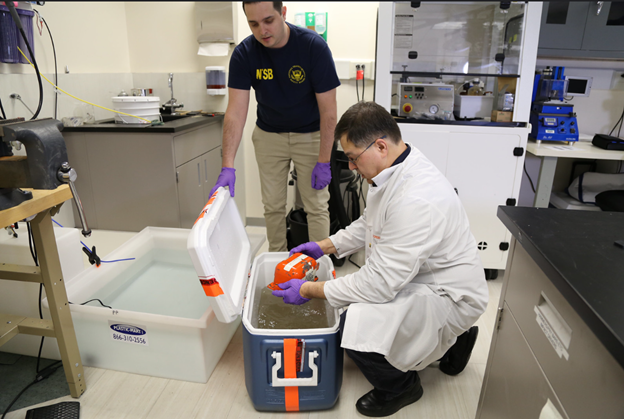
NTSB CVR specialists Joe Gregor and (kneeling) Sean Payne remove CVR from the 2019 crash involving Atlas Air flight 3591, a 767-300 in February 2019. Because the recorder had been submerged in water before being located, to prevent oxidation it is immersed in water for transport to NTSB recorders lab in Washington, DC.
0733:34 Tower: Eastern 212, cleared to land, 36.
0733:55 Captain to First Officer: All we got to do is find the airport.
0733:58 Sound of impact.
There’s a certain mystique surrounding the cockpit voice recorder (CVR). There was even a theatrical play, Charlie Victor Romeo, aptly named for the phonic initials of CVR, which used CVR transcripts to recreate the final moments of six flights. In 2004, Time placed Charlie Victor Romeo on its Best Plays of the year list. Years later, Charlie Victor Romeo was made into a film and premiered at the 2013 Sundance Film Festival.
I really don’t get it. I can tell you from experience of having to listen to scores of CVRs, there’s nothing entertaining about listening to one. Eerily, the CVR recording of USAir 405 revealed that minutes before the crash, the crew spoke my name while referring to an article that I had written.
Perhaps I had read too many accident reports to ignore its presence. The above-cited final seconds moments of Eastern 212 always resonated with me. The crash happened just months after I started flying. News broke of the pilots’ casual, nonchalant conversation as they performed a non-precision approach on that foggy morning in Charlotte, North Carolina. It was damming. In the final moments of flight, the pilots conversed amongst themselves about the then-Arab oil embargo, buying cars, trying to identify a local amusement park, the economic recession and the stock market. They then plowed the DC-9 into a corn field 3 miles from the runway. Seventy-two lives were lost.
As a newly minted private pilot, I was struck with that casual attitude. When I moved to the flight deck of an airliner some years later, I was keenly aware that there was quarter-sized microphone on the overhead panel, designed to capture every audible word spoken and sound in the cockpit. Perhaps that knowledge prompted me to be a more disciplined pilot, knowing that I didn’t want my family reading of my unprofessional behavior just before my demise.
Early in my airline career, I also found that not everyone was too pleased about the CVR requirement for airlines--a requirement that had been in place since the mid-1960s. One captain I flew with insisted on placing a rubber crutch tip over the microphone. I can only guess that his motivation was that if we crashed, he didn’t want Big Brother knowing what we had been discussing before we bit the dust.
Before analyzing a CVR, the NTSB forms a group to create a transcript of the recorder’s contents. The group is led by an NTSB CVR group chairman and typically has a representative from the FAA, the aircraft manufacturer and the company whose aircraft crashed. If the organization’s pilots are represented by a union, a pilot representative would typically be part of the group, too. That arrangement led to my first official duty of listening to CVRs.
In 1994, a Boeing 737-300 operating as USAir 427 crashed outside of Pittsburgh in 1994. I was an ALPA representative on the NTSB’s human performance group. We spent excruciating amounts of time listening to, and trying to analyze, precisely what was going on in that cockpit before it plunged into a Pennsylvania hillside. A few years later, a US Airways Fokker F-100 was struck by lightning, resulting in loss of both hydraulic systems. The crew did a nice job getting the plane on the ground, but the airplane veered off the runway upon landing. The nose gear collapsed in the mud adjacent to the runway. Fortunately, there were no serious injuries. As a current and qualified captain on the airplane, I was asked to serve as the ALPA rep on the CVR group. And, of course, during my 15 years as an NTSB board member, I listened to many recordings as part of my duties.
The CVR’s crash-hardened casing is required to withstand an impact of 3,400 Gs. It must also be capable of surviving 1,100 deg. C for 30 min. The downside is that because it’s so robust, getting into a damaged casing to retrieve the crash-protected memory case can require considerable effort.
Once accessed, the original recording is copied onto a server. Officials will quickly audition it to see if there is information that needs to be urgently related back to investigators in the field. If a press briefing is being conducted on scene, the spokesperson may characterize what is being done in the cockpit, but the actual words from the CVR aren’t disclosed at this time.
Guarded Listening
Access to the CVR is tightly controlled at NTSB. Even as NTSB chairman holding a top-secret security clearance, I was not able to access the recorders lab without an escort. There are three soundproof CVR audition rooms in the NTSB recorders lab. Only a small handful of people are ever allowed to listen to a CVR. Each person who listens must sign a CVR audition log and a CVR nondisclosure agreement beforehand. If there is a leak, it had to come from one of those people.
Notes are allowed, but only on a blue piece of paper that is distributed by NTSB. At the end of each day, that exact number of pieces of paper must be collected and destroyed. Cell phones must be left in storage lockers outside of the audition room.
At the beginning of the CVR group meeting, before starting the transcription process, the recording is played in its entirety without stopping. Group members listen through high-fidelity headphones.
The transcription process is done the old-fashioned way; the recording is played phrase by phrase, sometimes word by word, and the group tries to determine what sounds and words were heard. As you can imagine, oftentimes certain words, phrases and sounds are replayed until there is clear understanding of the content. While the recording is being played, the NTSB group chairman types what is heard. That content is displayed on monitors directly in front of each group member. Consensus on transcribed content should be achieved before moving on. Discussion that appears totally unrelated to the accident is often not transcribed, but instead, will be reflected in the transcript as “non-pertinent conversation.” People’s names are replaced with @ for privacy. In the USAir 405 crash, my name was depicted as Robert @. Expletives are replaced with #. One recording I listened to involved the crash of a Learjet 35A at Teterboro. That one had over 110 “expletive deleted” between takeoff and 26 minutes later when the aircraft stalled and crashed.
Through use of sound spectrum analysis, investigators can use the CVR to identify or confirm the source of sounds. This is often done by recording a sound from an exemplar aircraft and then comparing those sound signatures to ones heard on the CVR.
In the 2019 crash of an Atlas Air Boeing 767-300 freighter outside of Houston, for example, investigators confirmed that a click heard on the CVR was, in fact, consistent with the sound signatures of the go-around switch being activated in the accident aircraft. When a Bombardier Learjet 60 overran a runway in South Carolina in 2008 following a rejected takeoff, because the aircraft was not equipped with a flight data recorder, investigators used sound spectrum analysis to determine engine RPM. They also calculated the airplane’s initial acceleration and ground speed by measuring the time between tires rolling over the grooved runway.
Recording Not Released
The CVR group’s transcription of the recording becomes the official record of the CVR’s contents. By law, NTSB is prohibited from releasing the actual audio recording. This is the result of events following the August 1988 crash involving Delta 1141 at DFW Airport. NTSB found the pilots failed to set the flaps before takeoff and crashed immediately after liftoff. Following a year-long Freedom of Information Act battle with a local Dallas TV station, a judge ordered NTSB to release the actual recording. It was played on the air. To put it mildly, it was a bombshell. There was nearly 8 min. of what the official NTSB transcript described as “non-pertinent conversation between the flight crew and flight attendant” who was visiting the flight deck during taxi-out.
However, the actual recording revealed that content wasn’t non-pertinent at all. It revealed the extent of the crew’s unprofessional and casual attitude. ″We forgot to discuss about the dating habits of our flight attendants so we could get it on the recorder in case we crashed. Then the media would have some kind of a juicy tidbit,″ one crew member said. “We gotta leave something for our wives and children to listen to.″
In response to the release of the cockpit recording, ALPA revolted. Congress reacted by passing a law prohibiting NTSB from releasing it. However, once the NTSB is through with the actual recording, they return it to the owner/operator of the aircraft. There is no prohibition on that entity releasing it. In fact, oftentimes the actual recording is used in litigation. It’s not unheard of to have a recording played in open court, although it’s more common for a judge to hear it privately in chambers. The law judge will then determine if it can be played in the courtroom in front of the jury and spectators.
As a side note, in the final report of Delta 1141, NTSB apparently decided those CVR comments weren’t “non-pertinent,” after all. It concluded: “Extensive non-duty related conversations and the lengthy presence of the flight attendant in the cockpit reduced the flightcrew's vigilance in ensuring that the aircraft was properly prepared for flight.”
If there’s any lesson from all of this, it’s a simple one. It’s one that I always tried to remember: As a professional pilot, it’s always good to be cognizant of the CVR. Contrary to what the pilots of Delta 1141 said, you don’t want to leave something like this for your wife and children.





